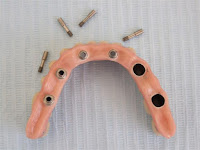In
this age of technological and medical advancement, with people living
longer and healthier lives, lost teeth replaced by removable dentures
will become a thing of the past, reserved for the history books.
Dental implants are man-made replacements for natural teeth. The
implants themselves are designed to be similar to tooth roots. They
are anchored in the jaw bone and replacement teeth are permanently
secured upon them.
Firstly, the titanium implant is placed in the jawbone during a minor surgical procedure. The implant will remain covered under the gum for 3-6 months and during this time the implant will become integrated with bone, forming a very strong bond. This process is known as osseointegration.
Once osseointegration has taken place, the ends of the implants are uncovered and connections are attached so that replacement teeth can be put in place.
in the hands of Dr Jorge Santillan,a highly trained Specialist Implantologist, who works Clinica Dental La Plaza, Javea these replacements mimic natural teeth to such a degree that you would be very hard pressed to tell the difference.
Since implanted teeth are fixed in the mouth like natural teeth rather than being removable like dentures, they allow the patient to return to the functions associated with natural teeth.
Firstly, the titanium implant is placed in the jawbone during a minor surgical procedure. The implant will remain covered under the gum for 3-6 months and during this time the implant will become integrated with bone, forming a very strong bond. This process is known as osseointegration.
Once osseointegration has taken place, the ends of the implants are uncovered and connections are attached so that replacement teeth can be put in place.
in the hands of Dr Jorge Santillan,a highly trained Specialist Implantologist, who works Clinica Dental La Plaza, Javea these replacements mimic natural teeth to such a degree that you would be very hard pressed to tell the difference.
Since implanted teeth are fixed in the mouth like natural teeth rather than being removable like dentures, they allow the patient to return to the functions associated with natural teeth.
Whether
you have only one missing tooth or you suffer the discomfort and
embarrassment of full dentures, which do not fit securely, implants
provide you with fixed teeth again. They can take years off your
appearance, make your mouth feel naturally comfortable again, allow
you to speak with greater clarity, more fully participate in physical
activities and hence boost your self-confidence. Because they
increase your chewing ability you will once again be able to enjoy
all foods thus your overall health and well-being will be enhanced
.
In short they can vastly improve the quality of your life.
Sometimes
a single dental implant will suffice. In other instances, more than
one dental implant is necessary to accomplish a natural looking tooth
replacement.
The
x-ray images demonstrate how dental implants are rooted to the
jawbone.
Two
dental implants used in tooth replacement and a single dental implant replaces the missing tooth. The photos below show dental implant photos of a molar replacement and are a good example of
surgery commonly performed by an implant dentist
Missing
Molar and Titanium post and artificial tooth
These
photos show an upper and lower jaw rehabilitated with dental implants
(Dr Jorge Santillan)

Article
provided by Dr.Karen Gardner , Clinica Dental La Plaza, Javea, Tel 96
646 1120
Anyone
interested in these or any other treatments is invited for a free
consultation at our dental clinic in La Plaza








